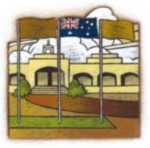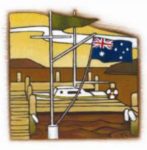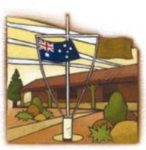- Author
- A.N. Other and NHSA Webmaster
- Subjects
- History - general
- Tags
-
- RAN Ships
- None noted.
- Publication
- June 1996 edition of the Naval Historical Review (all rights reserved)
Hoist: The half of a flag nearest to the halyard (that is, the rope by which a flag is raised and lowered)
Fly: The half of the flag farthest from the halyard.
Canton: The place of honour in a flag is the upper half of the hoist. It is also called the First Quarter and sometimes the Upper Hoist.
Second Quarter: The upper half of the fly.
Third Quarter: The lower half of the hoist. It is also called the Lower Hoist.
Fourth Quarter: The lower half of the fly
Description and Dimensions
The Australian National Flag has a dark blue field with the Union Jack occupying the upper hoist, a large white star in the lower hoist and five white stars in the form of the Southern Cross in the fly. The length of the flag is twice the width.
Note: The Australian Army is the protector of the Australian National Flag by which it is represented.
Etiquette – Australian National Flags with Flags of Sovereign Nations
 The Australian National Flag when flown or paraded, takes precedence over all other national flags. When flown with the flags of other sovereign nations all flags should be flown on separate poles and at the same height, all being of the same size, with the National Flag occupying the position of honour.
The Australian National Flag when flown or paraded, takes precedence over all other national flags. When flown with the flags of other sovereign nations all flags should be flown on separate poles and at the same height, all being of the same size, with the National Flag occupying the position of honour.
International practice forbids the display of the flag of one nation above that of the other in times of peace. The Australian National Flag should, however, be raised first and lowered last unless the number of flags permits their being raised and lowered simultaneously.
With the flag of one nation, the Australian National Flag should be on the left of the flags, both should be at the same height.
 In a line of flags representing a number of sovereign nations, where there are three or more making an odd number of flags, the Australian National Flag should be flown in the centre when only one Australian flag is available.
In a line of flags representing a number of sovereign nations, where there are three or more making an odd number of flags, the Australian National Flag should be flown in the centre when only one Australian flag is available.
If there are an even number of flags representing a number of sovereign nations, the Australian National Flag should be flown on the left of the observer facing the flags.
 If a flagpole is fitted with a gaff the flag on the gaff has the position of honour
If a flagpole is fitted with a gaff the flag on the gaff has the position of honour
 When displayed on a flagpole fitted with a yardarm with a flag of a sovereign nation or a State flag the Australian National Flag is displayed on the left of a person facing the flags.
When displayed on a flagpole fitted with a yardarm with a flag of a sovereign nation or a State flag the Australian National Flag is displayed on the left of a person facing the flags.
If carried with other flags, in single file, the Australian National Flag should always lead.
When crossed with a flag of another sovereign nation the Australian Flag should be on the left and its staff should be in front of the other staff.
Days of National Commemoration
Special days for flying the Australian National Flag.
- 1 Jan – Anniversary of establishment of the Commonwealth of Australia (1901).
- 26 Jan – Australia Day
- March Second Monday – Commonwealth Day
- Anzac Day – (flags flown at half-mast till noon, then at peak for remainder of the day.)
- June Second Monday – Queen’s Birthday is celebrated (except W.A. where held in October).
- 3 Sept – Australian National Flag Day – anniversary of our Flag, first flown in 1901.
- 11 Nov – Remembrance Day (flags flown at peak till 10.30 am, at half mast from 10.30 am to 11.03 am, then at peak for the remainder of the day).
The Australian Flag
There has been a lot of uninformed discussion recently as to the use of the Australian Flag by the country’s armed forces in peace and war. The following extract from George Odger’s book, “The RAN, an Illustrated History” indicates quite clearly that the RAN was ordered to wear the Australian Flag at the jackstaff from 5 October 1911:
“On 5 October 1911, the existence of the new Australian Navy was formally advised when the Naval Board issued an historic order promulgating the designation ‘Royal Australian Navy’ (this had been approved by the King on 10 July 1911) for the permanent naval forces of the Commonwealth and for the ships of the Navy to be designated ‘His Majesty’s Australian Ships’. The order also directed that all ships and vessels of the Royal Australian Navy were to fly at the stem the White Ensign as the symbol of the authority of the Crown and at the jack staff, the flag of Australia.”




